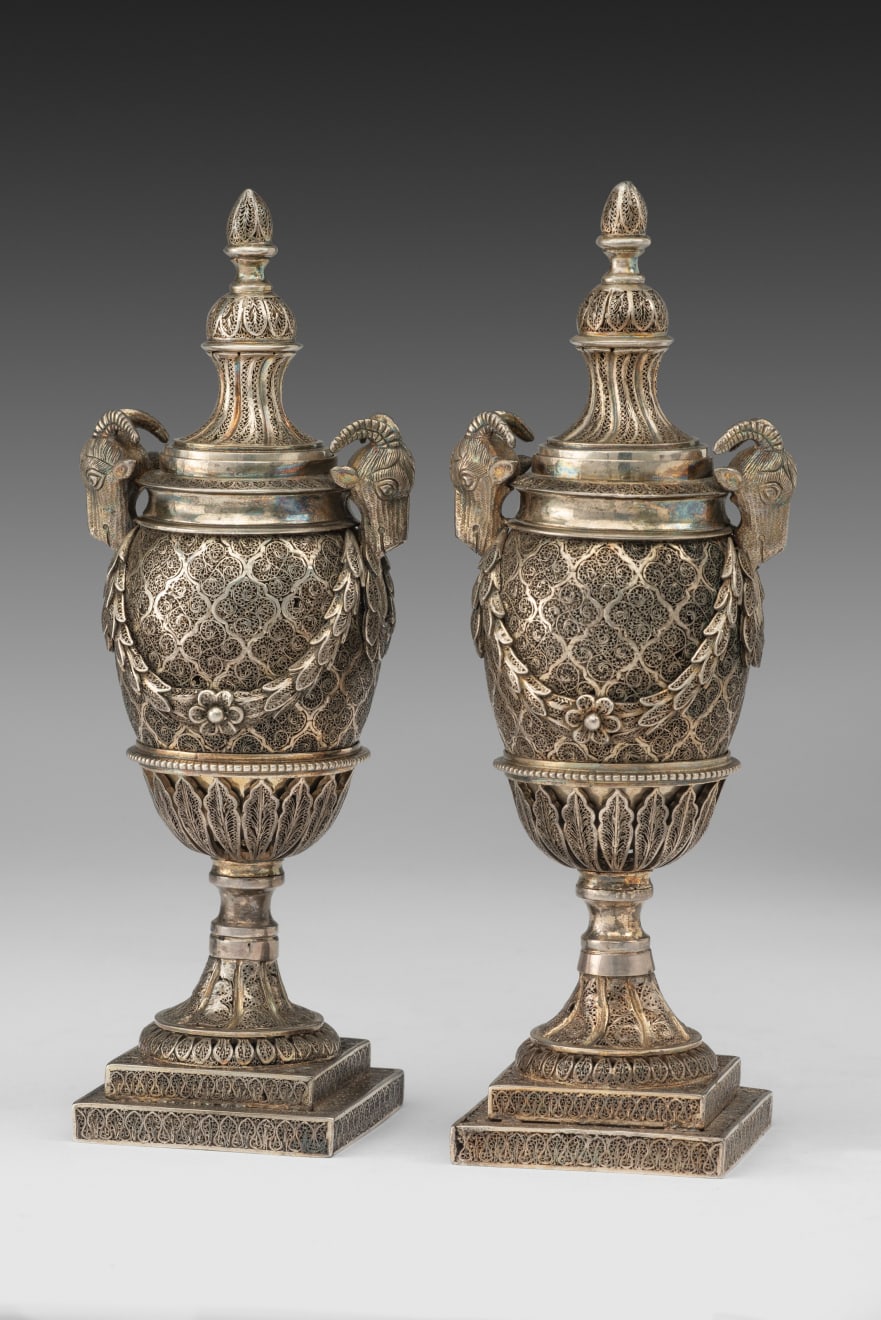Pair of Anglo-Indian Filigree Silver Cassolettes after the model by Matthew Boulton
INDIA, CIRCA 1800
22 x 6 x 6 cm
8 ¾ x 2 ¼ x 2 ¼ in
8 ¾ x 2 ¼ x 2 ¼ in
JL42
Further images
Provenance
Private Collection, Switzerland
Each formed as an urn with a ram's head to each side issuing laurel swags centred by a flowerhead, the reversible top with a serpentine fluted and foliate finial and...
Each formed as an urn with a ram's head to each side issuing laurel swags centred by a flowerhead, the reversible top with a serpentine fluted and foliate finial and a turned and reeded
nozzle, on a fluted foot with spiral and foliate filigree decoration, raised on and square
stepped plinth.
The origin of such items is difficult to ascertain as this type of work is not stamped. However, they were certainly created along trade routes of areas such as Batavia and Goa. The work on this pair may point to the Karimnagar silver filigree workers. Examples of such fine work by makers from this region can be found in the Salar Jung Museum, India. However, the form and function of this pair of cassolettes is based entirely on an English design.
Thomas Coulborn and Sons sold a pair of George III Ormolu and Blue-John Candle Vases by Matthew Boulton (1728-1809), the form of which inspired this pair of cassolettes. The 'goat's head vase' is derived from a sketch illustrated in Boulton and Fothergill's pattern books preserved in the Birmingham City Archives (Pattern Book 1, p.171). The model was one of the most popular of the smaller vases and first appeared in 1769 when a Mrs Yeats ordered '1 pair of goat's head vauses light blue cheny or enamelled'. In the same year, Sir William Guise ordered a pair with blue-john bodies. Other buyers of goat's head vases include Lord Digby in 1774 and Lord Scarsdale in 1772. (See N. Goodison, Matthew Boulton: Ormolu, London, 2002, p. 331-333, figs. 332-333).
Other pairs are extant, some with filigree ball feet. A pair recorded in The Spangle Bedroom at Knole, Kent was probably acquired by Lord Amhurst in the early 19th century. They are illustrated in the National Trust guide book for the property, 1980, p. 25. A silver gilt pair are in the collection of the Liang Yi Museum, Hong Kong (LYMS-H-150).
nozzle, on a fluted foot with spiral and foliate filigree decoration, raised on and square
stepped plinth.
The origin of such items is difficult to ascertain as this type of work is not stamped. However, they were certainly created along trade routes of areas such as Batavia and Goa. The work on this pair may point to the Karimnagar silver filigree workers. Examples of such fine work by makers from this region can be found in the Salar Jung Museum, India. However, the form and function of this pair of cassolettes is based entirely on an English design.
Thomas Coulborn and Sons sold a pair of George III Ormolu and Blue-John Candle Vases by Matthew Boulton (1728-1809), the form of which inspired this pair of cassolettes. The 'goat's head vase' is derived from a sketch illustrated in Boulton and Fothergill's pattern books preserved in the Birmingham City Archives (Pattern Book 1, p.171). The model was one of the most popular of the smaller vases and first appeared in 1769 when a Mrs Yeats ordered '1 pair of goat's head vauses light blue cheny or enamelled'. In the same year, Sir William Guise ordered a pair with blue-john bodies. Other buyers of goat's head vases include Lord Digby in 1774 and Lord Scarsdale in 1772. (See N. Goodison, Matthew Boulton: Ormolu, London, 2002, p. 331-333, figs. 332-333).
Other pairs are extant, some with filigree ball feet. A pair recorded in The Spangle Bedroom at Knole, Kent was probably acquired by Lord Amhurst in the early 19th century. They are illustrated in the National Trust guide book for the property, 1980, p. 25. A silver gilt pair are in the collection of the Liang Yi Museum, Hong Kong (LYMS-H-150).








